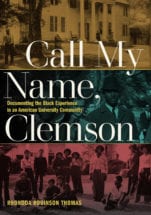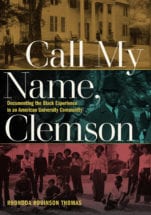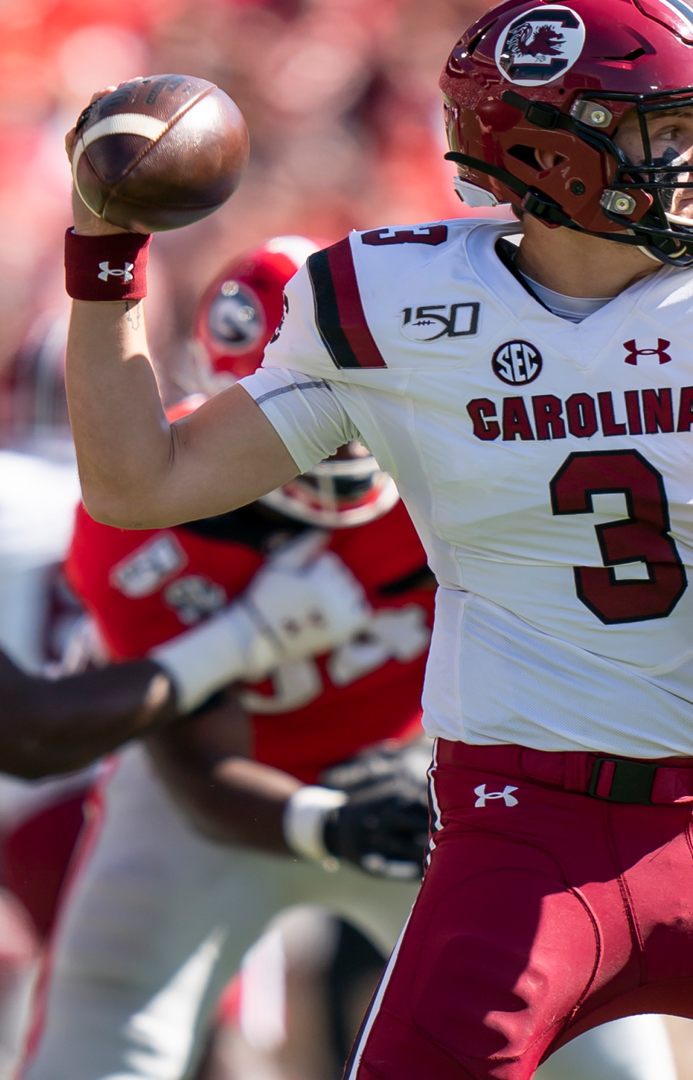Thomas explores marginalized African American lives in ‘Call My Name, Clemson’

There’s a name Rhondda Robinson Thomas can’t mention without almost breaking into tears. It belongs to Caty, an enslaved baby listed on the 1854 deed for John C. Calhoun’s former home, Fort Hill.
Caty’s age is recorded as “zero.”
“I want to know Caty’s story,” said Thomas, who researches the history of African American laborers at Clemson University, built on the former Fort Hill Plantation.
“I keep calling Caty’s name, even though I can hardly say it without crying,” she said. “I want someone to say, ‘I recognize that family.’ Those are the stories that tear at my heart, the stories I want to tell fully one day – about the babies, the children, the most vulnerable.”

The desire to document the lives of the enslaved persons, sharecroppers and prison laborers who helped build Clemson University inspired Thomas’ long-term project, “Call My Name: African Americans in Clemson University History.”
Thomas, the Calhoun Lemon Professor of Literature, has digitized more than 2,000 primary records related to Clemson history, including inventories of enslaved persons, prisoner records, labor contracts, photographs and correspondence. She’s created a Call My Name website, initiated a social media campaign, conducted campus tours and presented scholarly papers about her research.
Most recently, Thomas published Call My Name: Documenting the Black Experience in an American University (University of Iowa Press).
Clemson News recently discussed the book with Thomas via Zoom.
Clemson News: Would you say that Caty and others like her are the inspiration for the “Call My Name” project and book?
Rhondda Thomas: Caty is a particularly poignant part of the story because we really know nothing about her. That 1854 list of enslaved people also includes a one-year-old identified only as “Baby” – the child doesn’t even have a name. And there are the stories of the convicted laborers, especially those who are under the age of 16. There’s something heart-wrenching about a 12-year-old, Simon Davis, who is convicted of stealing a piece of jewelry and ends up in the state penitentiary with grown men who are convicted of murder and rape. In 1894, he’s assigned to the convicted laborer crew that built Clemson College.
CN: You mention in the book that Simon and many other convicted laborers were driven by poverty and desperation.
RT: So many of those young men were convicted of stealing, which should have been petty theft. People were stealing food or clothing to survive. Because most of them were enslaved or convicted laborers, they lost their identity in systems of oppression. The opportunity now is to restore those narratives, to ask family members to fill in those stories, to give them a biography. It restores their humanity. They become human beings, a son, a brother, a father, not a convict, not enslaved.
CN: This book seems to be a very personal one, with your reflections on your own family.
RT: Because Call My Name is a public history project, because my story is part of Clemson’s story and because I am a South Carolinian, I felt I had to incorporate little snippets of my own narrative and my family’s story more than I ever have. In South Carolina, the founding families were few and powerful. My own paternal grandmother’s family is connected to one of South Carolina’s major slave-owning families, the Wanamakers. So, part of the book is my own story of coming back home after college and finding that Clemson’s story is part of my own family’s story.
CN: The narrative follows a “Call-and-Response” format, with individual stories of blacks who contributed to Clemson’s history followed by a response from students, professors and others. Why did you choose this technique?
RT: This was to underscore that this is a community-based story where people have to talk to each other in order to share ideas and stitch these stories back together, piece by piece. When there’s a piece of a person’s story that’s missing, if I put out a call maybe someone will answer and provide another piece of that puzzle. The story of African Americans and Clemson history is not in the archives, though we have lots of lists of enslaved people, sharecroppers and convicted laborers. In order to fill out those stories, I have to call out those names publicly and invite the public to help me tell those stories so that we move from simply calling those names to actually filling in people’s lives.
CN: You trace the beginning of the Call My Name project to your first day as a faculty member on campus in August 2007 when you first saw Fort Hill.
RT: Yes, I said to myself, “How is there a plantation house in the middle of the Clemson campus?” I was astounded that Clemson was built on John C. Calhoun’s plantation and no one was talking about it. No one was talking about enslaved persons on the tour of the house. When I first went to find the inventories of enslaved people in the archives, nobody knew what I was talking about.
Many universities and colleges had connections to the history of slavery, and very few at that time were investigating those stories. It was not standard practice in higher education institutions at that time.
CN: Your book includes contributions from several Clemson graduates, including Eric Young, a direct descendent of enslaved people who worked on Calhoun’s plantation.
RT: There’s a photo in the book of Eric’s ancestors against the backdrop of Fort Hill, and through Eric their story comes to life. It’s the story of the Fruster family, a huge extended family, but Eric was the first member of the family to attend Clemson and graduate, in 1995. That’s the excitement of the Call My Name project: I called the name of two Frusters and got generations of stories by listening to one person then listening to two cousins talking to each other. When you meet a descendent and they start taking you backwards to the patriarch or matriarch of the family, the stories come to life.
CN: Was it important to you to include student voices in the book?
RT: Because it’s a community project, we wanted to include members of the descendent community, but I thought it was also important to include the voices of those who helped develop the project, my research assistants. For instance, I wanted an African American male who was at Clemson responding to the history of the young African American men who built this college that they couldn’t attend. I met Thomas Marshall III (a 2020 graduate in English) on a Call My Name campus tour. He just seemed like the person who should write that piece and he did a beautiful job, talking about having a seat at the table.
CN: What do you hope readers will ultimately take away from this book?
RT: I think it’s in the title: “Call My Name, Clemson.” This chorus of voices engaged in this project are calling on the University to fully incorporate the history of black people into the official narrative. The voices from the past are beckoning through descendent communities to say, “When you tell your story, Clemson, call my name.” This call is to Clemson but it’s also to South Carolina and America and any community that has hidden history. What voices in your community have been distorted or marginalized or silenced?
The post Thomas explores marginalized African American lives in ‘Call My Name, Clemson’ appeared first on Clemson News.
Click Here for the Full Article
Author: Paul Hyde







